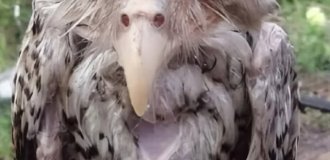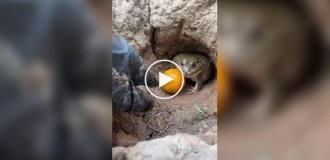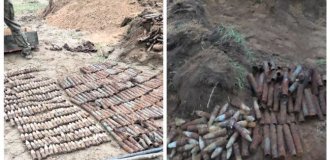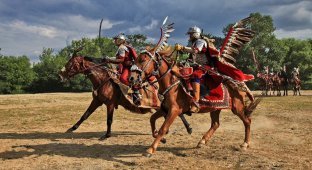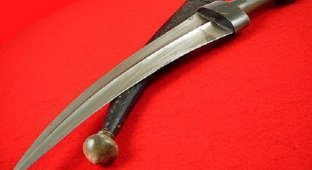Saber (Hungarian czablya, from szabni - to cut), a chopping or cutting-piercing weapon.
Consists of a blade, hilt and sheath. The blade - curved with a blade on the curved side and a butt on the concave side - has a tip (sometimes fullers) and a shank for attaching the hilt. The combination of the curvature of the blade with a significant distance from the center of gravity from the hilt increases the force of the blow and the area of the affected space. This feature of the saber was most effective with blades made of hard steels, which had high elasticity and ductility.

The hilt has a handle with a lanyard and a cross with a crosshair (oriental sabers) or another guard (European sabers). The scabbard can be wooden, covered with leather, morocco and velvet or metal (19th - 20th centuries), blued, chrome-plated and nickel-plated on the outside.

The saber appeared in the East and became widespread among the nomads of Eastern Europe and Central Asia in the 7th - 8th centuries. The saber of this people is cutting and piercing. In the 14th century Yelman appears on the saber. The saber acquired the properties of a predominantly cutting weapon. The most characteristic sabers of this type were Turkish and Persian. Both have a straight handle, a cross with a crosshair on the hilt, low weight (without sheath 850 - 950 g, with sheath - 1100 - 1250 g), large curvature of the blade, blade length 750 - 850 mm, total length of the saber 950-970 mm. In European armies of the 18th - 19th centuries. sabers had blades of medium curvature (45 - 65 mm), hilts with bulky guards in the form of 1 - 3 arches or cup-shaped, scabbards from the 19th century. usually metal. The total length reached 1100 mm, blade length 900 mm, weight without sheath up to 1100 g, weight with metal sheath up to 2300 g. At the end of the 19th century. the curvature is reduced to 35 - 40 mm. and the saber again acquires piercing and chopping properties.

Several types of sabers are common in the Caucasus. They are decorated and partly made according to national, historically established patterns, so in most cases the place of their production can be determined by the ornament.

The light Caucasian saber has a very wide short blade of weak curvature with fullers and a very sharp end. The handle has a flat-oval cross-section, gradually tapering towards the head, which is made in the shape of an animal head with an open mouth. The crosspiece is small, Iranian type. The scabbard is wooden, covered with leather, with an Iranian-style instrument.

The heavy Caucasian saber has a wide, heavy long blade, often with fullers and yelman, a massive bone or horn handle with a knob in the shape of a bird's head and a large massive cross. The scabbard is large, flat with a heavy device; a comb is usually made at the tip.

The usual Iranian saber "shamsher" has a narrow blade with a large curvature and a smooth bend. The handle is thin with a small cross and head. The scabbard is wooden, covered with leather. The scabbard device usually consists of two metal holders with rings and often a tip.

Khevsur saber
Khevsur sabers in most cases belong to the type of light Caucasian sabers. The linings on the handles and sheaths and the ornaments on them are the same as those of the Khevsur broadswords.

Light Armenian saber.
Armenian sabers. Light Caucasian sabers were common in Armenia, as well as Iranian “shamshers” with a characteristic geometric pattern on the handle and scabbard. In the center of the ornament there is a diamond-shaped rosette, composed of spirally writhing lines, and an image of animals (tigers or lions). Ornaments are usually made with copper, silver or gold tauching.

Azerbaijani sabers.
They are made according to the type of light Caucasian and Iranian “shamshers”. Usually their metal device is decorated with a large, densely arranged floral and floral ornament, made of gold or silver notch. The peculiarity of this ornament is the pronounced stylization of its elements and some asymmetry.

Heavy Azerbaijani saber.
But most common in Azerbaijan were heavy Caucasian sabers, usually decorated with gold or silver notches. The ornament has strong elements of Muslim art: arched motifs, rare highly stylized petals on twisting branches, enclosed in peculiar cartouches.

Dagestan saber.
Light Caucasian sabers with an Iranian-type blade were widespread in Dagestan. These sabers, especially those made in Kubachi, are distinguished by the exceptional proportionality of their component parts and great elegance of shapes and decorations. Over the centuries, Kubachi craftsmen have created many techniques for decorating their weapons. There is simple and deep engraving, niello and gilding, shotting and notching, carving and armor, the combination of which gives the weapon a rich look.

Kyrgyz sabers.
The most ancient of the surviving examples of weapons are the Kyrgyz sabers, narrow, long, with bayonet-shaped ends, adapted for piercing through the rings of chain mail. The handles of these sabers with a very short cross are usually covered with shark skin; The sheath on the left side is covered with the same material, and the right side is covered with birch bark. The frame of the heads of the handles and the holders on the scabbard is most often silver with an engraved or nielloed ornament.
In Central Asia, there was a national form of sabers with a narrow blade with a slight bend and a simple handle with a very small straight cross and a large head slightly tilted back. The scabbard is wooden, with characteristic holders and a tip. There is no mouth. These sabers became especially widespread in Kyrgyzstan, which is why they are usually called Kyrgyz.
In Central Asia, sabers like the Iranian “shamshers” are also widespread. Usually they receive a constructive or decorative addition - a kind of leather cover over the entire handle, which allows you to hold such a saber more firmly in your hand. These sabers differ from the Iranian ones and from each other mainly in the artistic ornament made on their device by engraving, chasing, embossing, enamel, niello, gilding, notches in combination with colored stones and turquoise.

Bukhara and Khiva sabers.
The most characteristic decoration of Central Asian weapons remains turquoise and enamel in turquoise and blue colors. Turquoise and enamel are used especially widely in the processing of hilts and sheaths of Bukhara and Khiva weapons. Hammered and stamped silver sometimes completely covers the handles and scabbards of Central Asian weapons. The blades of Bukhara and Khiva sabers are very close in shape to Persian ones. Belts are decorated with massive silver plaques, also usually with turquoise.
Here, imported Persian blades were often used in the manufacture of sabers. But the shape of Bukhara sabers - with a small yelman on a narrow blade - is of local origin. The decoration of Khiva sabers and other weapons is dominated by massive silver with a symmetrical floral pattern made by deep chasing. The blades of Central Asian checkers are almost straight with a decomposed blunt or butt, the handles are massive, thickening towards the head. Some types of large Central Asian knives follow the shape of checkers.
Bukhara sabers in Uzbekistan are most often decorated with stylized floral patterns made of painted or cloisonné colored enamel.

Khiva saber.
Khiva sabers are decorated with chased silver with large floral and floral ornaments in the form of apple blossoms.

Tajik sabers.
Those with massive hilts are usually identified by their scabbard, decorated with thin silver with an asymmetrical large floral design, applied with light, shallow chasing or embossing. In Tajik sabers, in addition, the handles were usually entirely covered with leather or suede with the same loop for putting on the hand. The scabbard was often covered with fabric instead of leather. The sheath of Bukhara sabers was usually covered with black leather, the handles were made from a whole piece of jade; turquoise, gems and silver were used to decorate the hilt, sheath and sword belt.

Georgian sabers (16th - 17th centuries).
In their mounting, hammered copper and engraved or smooth silver were widely used - plant-stylized ornaments, mainly consisting of bunches of grapes. In the 18th - 19th centuries. the scabbards of Georgian military weapons - sabers, checkers, daggers - were usually covered with leather or morocco, sometimes with velvet. Some Georgian sabers, 17th - 18th centuries. had more of a ceremonial purpose than a combat one. The handles of these sabers with a closed semicircular head had a very strong tilt back, and it was inconvenient to use them with such a tilt. A bell-shaped skirt made of morocco or covered with velvet was attached to the scabbard of such weapons. The device was usually made of slotted and chased silver, sometimes with gilding.

Afghan saber.
Afghan sabers do not differ in blade from Iranian or Indian sabers; their handles are usually made of steel with a large cross, the ends of which are curved down. Their ornamentation shows the intersecting influence of neighboring countries. To decorate blades and hilts and sheaths, notches, engravings, and armor are used. The ornament combines both oriental elements - arches, flowers, petals, and European plant and decorative elements - curls, shells, while so-called military trophies or weapon fittings are often depicted among the ornaments.

Iranian saber.
Iranian sabers are a classic example of oriental weapons with a long blade. Their blades are narrow, highly curvature with a smooth bend. The small thin handle has a small head and a straight long cross. Wooden scabbards are usually covered with embossed leather; the device consists of two clips and a tip. Among these sabers there are sabers with a blade without an elmani or, relatively rarely, with a small elmani.
In Kokand sabers, artistic floral patterns are usually applied using niello with engraving and gilding.



Turkish saber.
There are several types of sabers known in Turkey.
a) sabers with a heavy wide blade with a sharp curve. Its handle is massive, made of bone or horn, thickening towards the large, bent back head, and the crosspiece is long and straight. The scabbard is wooden, covered with leather in the middle part, with a large mouth, a frame with two rings, and a very long tip. To make it easier to remove the blade, the sheath has a special cutout at the mouth;
b) a lightweight saber of the same type with an Iranian-style blade, but with a sharp bend;
c) light officer's saber of the second half of the 19th century. with a small handle of the usual type and a small cross with the ends bent towards the blade.

Persian saber.
Blades from Persia have a slight curvature with a smooth bend; they are quite narrow. The small thin handle has a small head and a straight long cross. Wooden scabbards are usually covered with embossed leather; the device consists of two sides and a tip.

In Rus', the saber has been known since the 9th century, and since the 14th century. became the dominant type of weapon (in Western Europe - from the end of the 16th century). In the 15th - 17th centuries. The warriors of the Russian local cavalry, archers, and Cossacks were armed with sabers. From the 18th century In European and Russian armies, the saber was in service with light cavalry personnel and officers in other branches of the military. In 1881, in the Russian army, the saber was replaced by a saber and was preserved only in the guard as a ceremonial weapon, as well as among some categories of officers for wearing outside the ranks. In foreign armies, the saber was in service until the end of the 2nd World War, and after it they began to be used as a ceremonial weapon.

Polish hussar saber

Napoleonic saber




